We’ve been raising caterpillars again. With the severe lack of rain, I’m feeling concerned about Texas butterflies this year — we’ve had a definite drop in butterfly numbers, and it doesn’t help that wasps have been plentiful and on a very big caterpillar hunt lately. So the Caterpillar Hotel is back in business!
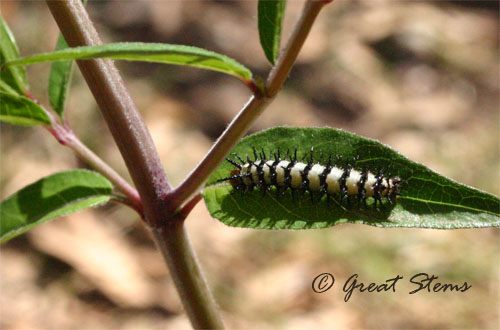
A Crimson Patch Caterpillar rests on a Flame Acanthus leaf.
At last month’s Austin Butterfly Forum meeting, the subject of the evening was the very same — raising caterpillars. Some members kindly brought caterpillars in for show and tell, and they offered to share the caterpillars with those who had the proper host plants at home. That’s how we came to have Crimson Patch caterpillars to raise — we have plenty of Flame Acanthus, their host plant. I don’t know whether these beautiful butterflies have visited our garden before — we often see the similar Bordered Patch butterflies (seen in the Caterpillar Hotel link above), but the Crimson Patch (Chlosyne janais) is recently extending its range into Central Texas. It is more commonly found in South Texas. Regardless, I hope these young ones will stay.
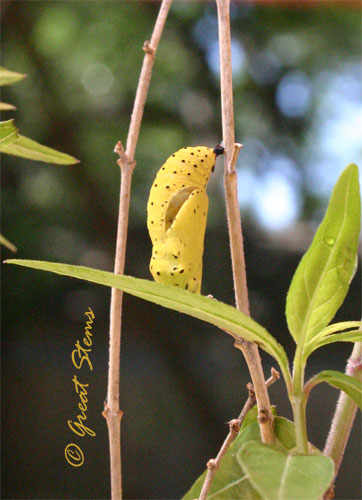
Crimson Patch caterpillars are relatively small; they are whitish-gray in color with black spines. As small as they are, they can quickly be lost as they wander off to form their chrysalis or to molt as they develop. Our first two caterpillars formed yellow chrysalises — the one above has a “clear” area on the chrysalis, but the butterfly emerged just fine. We have another chrysalis that is more white-gray in color — such variations are normal.
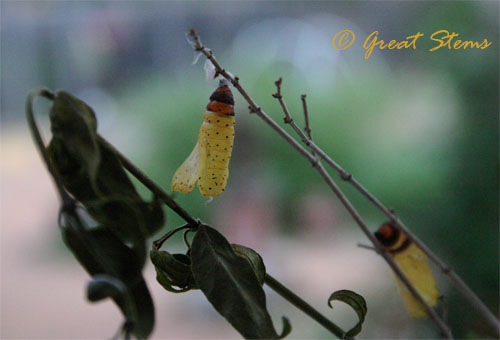
It only took about 8 days for our first Crimsons to emerge from their chrysalises. The shells left behind were just as beautiful as the newly formed ones.
And here is the adult Crimson Patch, still drying its wings after we moved it to a Texas Lantana for nearby nectar.
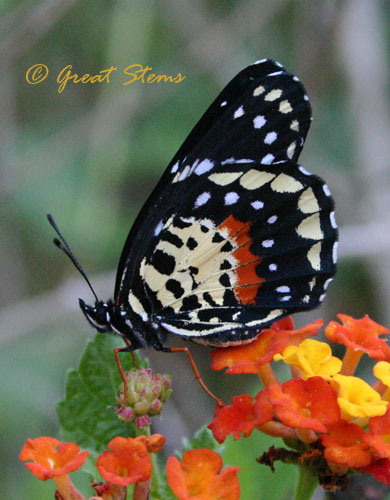
The dorsal hindwings sport the spots for which the Crimson Patch gets its name, though the patches are more red-orange than actual crimson in color (in contrast to the “spots,” the Bordered Patch’s red-orange color extends as a band across the upperside).
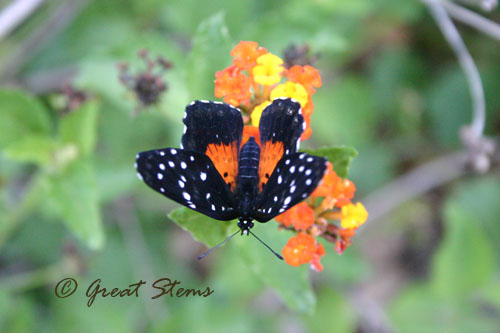
We’re looking forward to releasing the next set of Crimson Patch butterflies soon. Do stay tuned for some other very special caterpillars in our Caterpillar Hotel!
Beautiful pictures of beautiful butterflies! and I’m jealous…could you get some of those to stray east into Florida?
Beautiful! And how very cool there are people able to “show and tell” their lepidoptera guests in your area.
Lovely butterflies..I had read that parsley and dill are good to plant for the caterpillars so I am trying that this year…
Haha, Loret — once they are comfortable in Central Texas, I’ll be sure to send them your way.
Eliza, I do feel lucky — the butterfly organization here in Austin is a fantastic group.
Donna — I love, love, love growing dill and parsley for the Black Swallowtails — best of luck!
What an excellent project. We planted a section of our yard with flowers for our local butterflies this year.
Love the butterfly posts, as they’re aways informative as well as beautiful. I rarely choose plants based on their host properties, but I should. I will get some parsley plants for the swallowtails though (my seed never germinated)… should do that soon.
The photo of the Crimson Patch butterfly on lantana is gorgeous! I’ve been creating a garden with mostly native plants for several years now, and we get more butterflies each year.
The caterpillar shots are incredible- I have shot several butterfly photos but never the caterpillars. Caterpillar Hotel- love it. Will stay tuned.
K
They are beautiful butterflies and interesting looking caterpillars. Very nice that you can help Mother Nature along a bit. Over the years I have been adding host plants for specific butterflies and I have many more fluttering around in my garden now.
Can’t wait to check back on the butterfly hotel. I hope you get some rain soon!